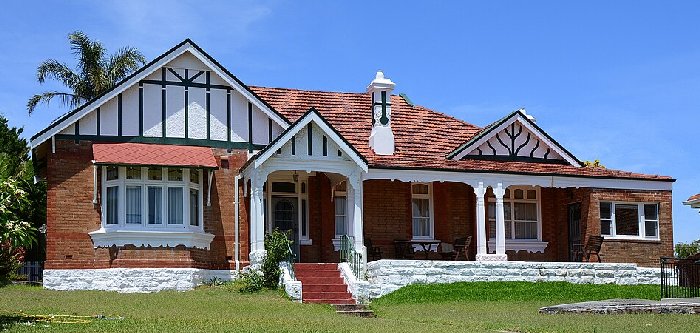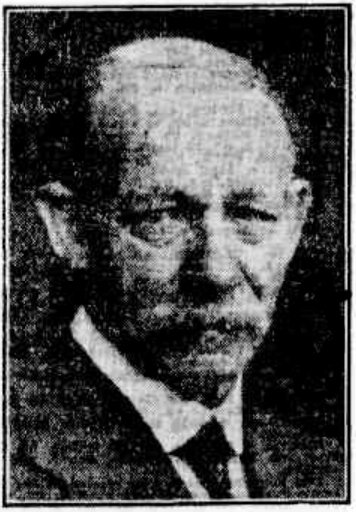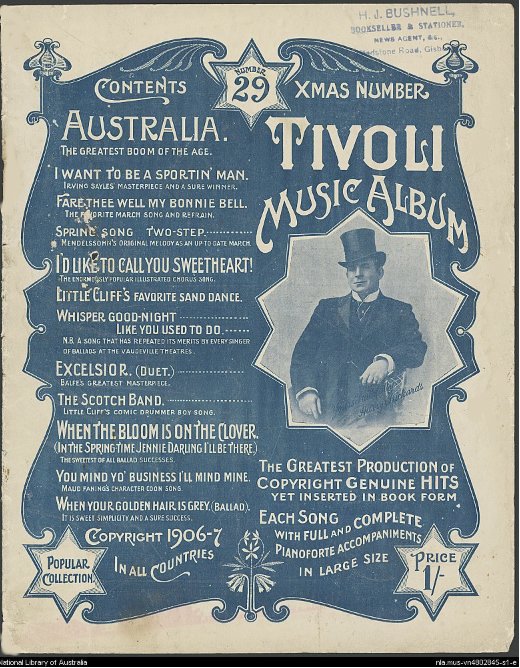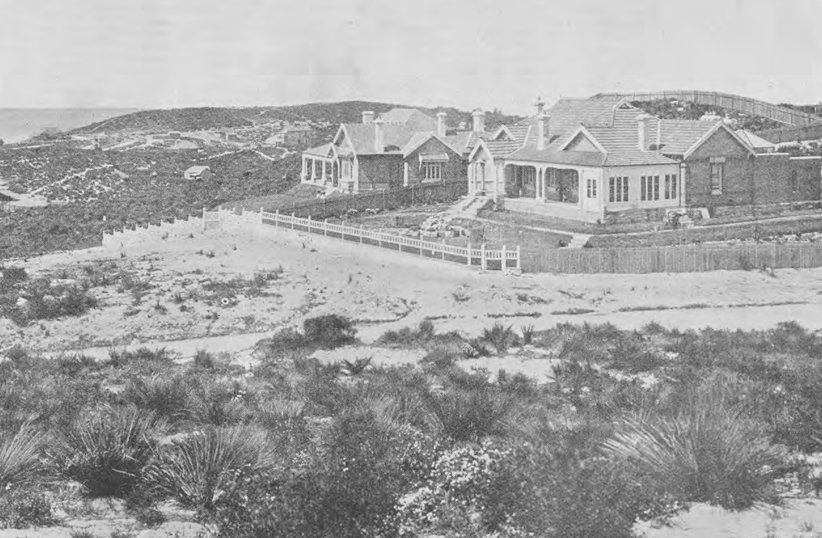Leete Park, Coogee
Leete Park, Coogee is a small triangular reserve bounded by Dudley, Higgs and Thomas Street. It is one of the highest points in Coogee at about 80 metres above sea level and provides
spectacular views east of Coogee and towards the ocean.

Leete Park, Coogee
Leete Park was named after John Charles "Jack" Leete (1857-1934), who was the general manager of Rickards Tivoli Theatre Ltd, the firm owned by his brother, the impresario Harry Rickards
(Henry Benjamin Leete 1843- 1911).
Jack Leete purchased a block of land in what is now Thomas Street in 1906 and built his house Eastbourne, a large attractive single storey Federation-style bungalow with sweeping
views over Coogee to the sea.

"Eastbourne" at 1 Thomas Street
Eastbourne - Historic Leete Residence
Eastbourne is one of Coogee's premier residences. It was, in the beginning, located at the corner of Melody (now Higgs) and Dudley (now Thomas) Streets, on Suburban Allotment Eastbourne, together
with the neighbouring Willaroon, was described as "new" when the nearby Hampstead Heights Estate was sold by auction in October 1907. The Sydney Sands Directory listed Eastbourne
for the first time at Dudley Street in 1908. After John C. Leete's death in 1934, the property was transferred to his wife, Nita Leete. Subdivision of the Eastbourne property occurred in 1928
(creating 1 Higgs Street), and again after Nita Leete's death, in 1949 (creating 1A Higgs Street). The residue was transferred to Myra Kathleen Tancred (the wife of Sydney businessman Henry Tancred) in 1949.
Further subdivisions occurred in 1959, when 1A Thomas Street was created, and in 1961, when the 3 Thomas Street allotment was subdivided. (see Note No. 1)

Jack Leete - 1930 newspaper photo
Jack Leete - Biography
Jack Leete was an interesting figure. Born in 1857, he led an adventurous life in his younger days, spending time in Egypt and East Africa. Leete was aboard the British ship HMS Shearwater, involved in the suppression of
the slave trade, at Zanzibar in 1874 when the body of the British explorer and missionary David Livingstone was carried from the African interior to be loaded onto the Euphrates to be transported
to Britain for burial and also managed to meet Sir Henry Stanley (of "Dr. Livingston, I presume" fame).
Leete passed up an offer from Stanley to take part in the exploration of Africa and instead decided to join his father in Cairo in Egypt where he worked on port construction.
When the Egyptians revolted against Britian and French imperial influence over the country in 1882, Leete acted as one the interpreters to Lord Charles Beresford, one of the British commanders.
In the military campaign of 1884, he was in charge of much of the railway work between Ismailia and his front, his services being recognised by the special thanks of General Sir Garnet Wolseley.
Jack Leete first came to Sydney in 1887 and took up employment with the Sydney Tivoli Theatre circuit owned his older brother Harry Rickards.
He became the general manager of Rickards' Tivoli entertainment business. Harry Rickards looked after the creative side of the business, while Jack Leete applied his considerable business acumen
to create a well- run business.

Tivioli Theatre Poster, c1910 (NLA)
The Tivoli circuit grew and prospered under Leete's management and featured some of the best vaudeville talent from all over the world, including people like Harry Houdini and W. C. Fields.
Rickards' entertainment was a large and complex business and reigned as the leading Australian music and vaudeville entreprise during the first quarter of the 20th century.
People went to the "Tiv" for entertainment not education and the management ensured they saw the best. As such, Jack Leete was an important businessman in his own right.
The Circuit was taken over after Rickards' death in 1911 by a succession of managements, the first was Hugh D. Mclntosh (known as "Huge Deal McIntosh") in 1912 and eventually by
J. C. Williamson theatrical company.
Jack Leete first married Diana Sharp (1858-1890). They had three daughters, Mabel, Diana, and Winifred Ethel married Nita Clarke, and a son Leslie who died in infancy in 1889. Diana Leete
died on the 11 February 1890 aged only 32 and was buried at Rookwood Cemetery. Later in 1897, Leete married Juanita Alvorado (1873-1948). She was a contralto balladeer and lyricist who performed
in Harry Rickards' companies, and performed under the stage name Nita Clark. Nita was a talented performer who earned good reviews for her stage performances and became a and important
figure Sydney's social scene, working in a number of patriotic and charitable causes.
Jack and Nita Leete travelled overseas for long periods during his retirement. This included stop-offs in Cairo to visit members of the Leete family who still lived in Egypt.
Jack Leete passed away in 1934 and was buried in Waverley Cemetery, alongside the grave of his brother Harry Rickards (Leete). Nita died in 1948 and was buried with her late husband.
Leete Park Created
In 1924, the vacant land fronting Thomas Street (and Eastbourne), described at the time as a "rough and rocky area", was gazetted by the State Government as a public recreation reserve,
on condition that local residents bear the cost of any improvements. Jack Leete came out of retirement to lead and effort to raise £8000 for the work. Local state parliamentarian Hyam Goldstein from the
conservative Nationalist Party, claimed in his election advertising that he was instrumental in have Leete Park gazetted as a reserve. Leete's fundraising efforts, his residences' close proximity to the park,
and his association with conservative politics, would seem likely enough reason for the park to be named after him.

"Eastbourne" at 1 Thomas Street (right)
overlooking the "rough and rocky" ground
that became Leete Park in 1907
Despite various municipal works undertaking over the decades, Leete Park remains largely an open expanse of grassland. It slopes steeply down to Dudley Street and is bordered by a few tall palm trees, with a solitary bench
tucked away in the southwestern corner. Its standout feature is the breathtaking view it offers, stretching over the Coogee basin and out to the sea.
Gruesome Discovery
On Sunday, January 8, 1933, Michael Vincent McDale, also known as McHale according to some accounts, was discovered dead in Leete Park. Aged 63 and residing on Prospect Street in the
nearby Paddington suburb, he was described as a “man of independent means.” His throat had been deeply cut from ear to ear, and his left wrist bore additional slashes.
A bloodstained razor was found near his body. McHale had been staying with relatives in the area and had reportedly been battling insomnia for some time.
Conclusion
Leete Park stands as a testament to the history and unique characters that shaped Coogee. From its beginnings as a rugged reserve to its transformation into a serene grassy expanse,
the park encapsulates the legacy of Jack Leete, a man of adventurous spirit and remarkable achievements in Sydney and abroad. Today, the park offers breathtaking vistas over Coogee and the ocean,
a quiet reminder of its fascinating heritage and the community efforts that brought it to life.
REFERENCES
Randwick Heritage Study Draft Heritage Items Heritage Inventory Sheets, 1 Thomas Street. Randwick City Council, 2022
'Passing of Mr Jack Leete'. Referee (Sydney), Thu 19 Apr 1934 , Page 9
'Mr. J. C. Leete' , The Sydney Morning Herald, Sat 28 June 1930, Page 19
'Mr John C. Leete, The Inquirer and Commercial News (Perth, WA), Fri 19 Aug 1898 , Page 4
'Leete Park', Sunday Times (Sydney), Sun 25 May 1924 , Page 6
'Family notices;, The Daily Telegraph, Sat 14 Apr 1934, Page 6
'Advertising [political ad for Hyam Goldstein]', The Hebrew Standard of Australasia (Sydney), Friday 22 May 1925, page 6
SLNSW, Coogee Subdivision Plans, Z/SP/C30/283a, The Hampstead Heights Estate, Coogee, 26 October 1907
'Found with throat cut', The Daily Telegraph, Mon 9 Jan 1933 , Page 7
'Casualties', The Sydney Morning Herald, Mon 9 Jan 1933 , Page 10
Note 1; Lot, 1 in Section 16a, of the Hampstead Estate was originally granted to Edward Henry Herring in 1856 and subdivided in 1897. Lot 1 of the subdivision was transferred to John Charles Leete,
on 30 July 1906.
Copyright © Coogee Media All rights reserved
|




